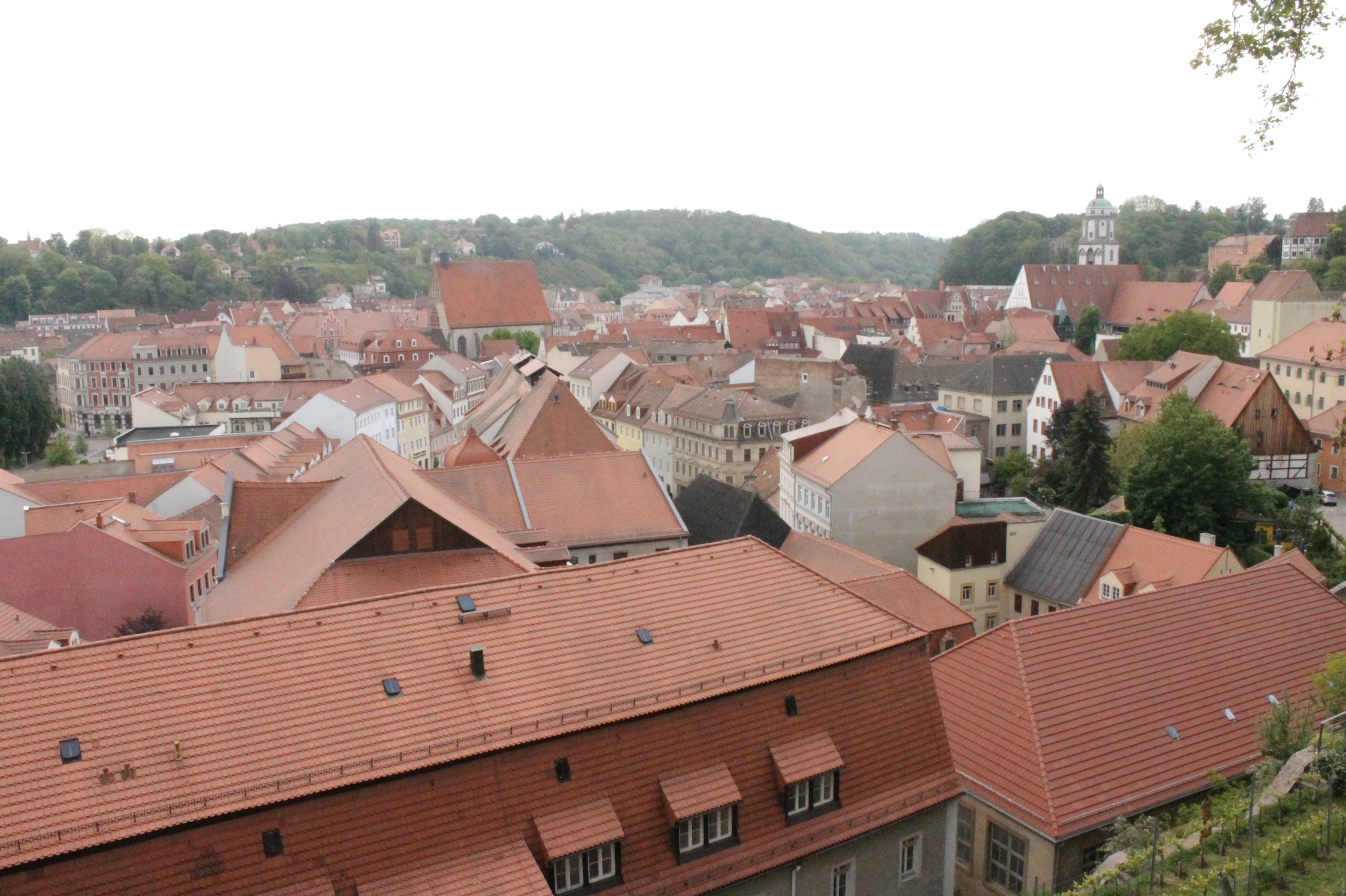|
Meißen Station
Meißen station is the largest railway station in the town of Meißen in the German state of Saxony. The station was opened in 1860 in the district of Cölln. Its entrance building, which was built in 1928, is a heritage-listed building and along with the Stuttgart Hauptbahnhof it is considered an architecturally significant transport complex of the interwar period. After the ending of long-distance traffic in the 1960s, the station is now a station of the Dresden S-Bahn with only regional significance. History During the planning phase of Leipzig–Dresden railway, the Leipzig–Dresden Railway Company (''Leipzig-Dresdner Eisenbahn-Compagnie''), considered a route passing through Meissen, but, in 1835, it selected a route running further north via Riesa because of the more favourable topography. It proposed to connect the then important town of Meissen with a branch line. This meant that in 1839 the citizenry of Meissen needed to travel to Priestewitz station or Oberau sta ... [...More Info...] [...Related Items...] OR: [Wikipedia] [Google] [Baidu] |
Meißen
Meissen (in German orthography: ''Meißen'', ) is a town of approximately 30,000 about northwest of Dresden on both banks of the Elbe river in the Free State of Saxony, in eastern Germany. Meissen is the home of Meissen porcelain, the Albrechtsburg castle, the Gothic Meissen Cathedral and the Meissen Frauenkirche. The ''Große Kreisstadt'' is the capital of the Meissen district. Names * german: Meißen * french: Meissen, ou, selon l'orthographe allemande: ''Meißen''; en français suranné: ''Misnie'' * la, Misnia, Misena, Misnensium * pl, Miśnia * cs, Míšeň * hsb, Mišno * dsb, Mišnjo * zh, 迈森 (pinyin: ) History Meissen is sometimes known as the "cradle of Saxony". It grew out of the early West Slavic settlement of ''Misni'' inhabited by Glomatians and was founded as a German town by King Henry the Fowler in 929. In 968, the Diocese of Meissen was founded, and Meissen became the episcopal see of a bishop. The Catholic bishopric was suppressed in 1581 after t ... [...More Info...] [...Related Items...] OR: [Wikipedia] [Google] [Baidu] |
Nossen
Nossen ( hsb, Nosyn) is a town in the Meißen (district), district of Meissen, in Saxony, Germany. It is located 80 km southeast of Leipzig. The town is dominated by a large Renaissance castle. Nossen is best known for its proximity to a motorway junction where the Bundesautobahn 14, A14 merges onto the Bundesautobahn 4, A4. Geography Neighboring towns Nearest towns are Roßwein, Großschirma, Reinsberg, Germany, Reinsberg and Striegistal in Mittelsachsen districts and Käbschütztal, Lommatzsch and Klipphausen in the Meißen district. History During World War II, a subcamp of Flossenbürg concentration camp was located here. Historical population From 1995, recorded on 31 December, unless otherwise noted:Datenquelle ab 1998: Statistisches Landesamt Sachsen Personalities Sons and daughters of the city * Friedrich Funcke (1642-1699), clergyman, cantor and composer * Paul Richter (1859-1944), architect * Friedrich Wilhelm Quintscher (1883-1945), founder of the or ... [...More Info...] [...Related Items...] OR: [Wikipedia] [Google] [Baidu] |
Triebischtal
Triebischtal is a former municipality in the Meißen (district), district of Meißen, in Saxony, Germany. Since 1 July 2012, it is part of the municipality Klipphausen. References Former municipalities in Saxony Meissen (district) {{Meissen-geo-stub ... [...More Info...] [...Related Items...] OR: [Wikipedia] [Google] [Baidu] |
Renaissance Revival Architecture
Renaissance Revival architecture (sometimes referred to as "Neo-Renaissance") is a group of 19th century architectural revival styles which were neither Greek Revival nor Gothic Revival but which instead drew inspiration from a wide range of classicizing Italian modes. Under the broad designation Renaissance architecture nineteenth-century architects and critics went beyond the architectural style which began in Florence and Central Italy in the early 15th century as an expression of Renaissance humanism; they also included styles that can be identified as Mannerist or Baroque. Self-applied style designations were rife in the mid- and later nineteenth century: "Neo-Renaissance" might be applied by contemporaries to structures that others called "Italianate", or when many French Baroque features are present (Second Empire). The divergent forms of Renaissance architecture in different parts of Europe, particularly in France and Italy, has added to the difficulty of defining an ... [...More Info...] [...Related Items...] OR: [Wikipedia] [Google] [Baidu] |
Bahnhof Meißen (1860)
Bahnhof (German for "railway station") is a Swedish Internet service provider (ISP) founded in 1994 by Oscar Swartz in Uppsala, Sweden, and is the country's first independent ISP. Today the company is represented in Stockholm, Gothenburg, Uppsala, Borlänge, Malmö and Umeå. WikiLeaks used to be hosted in a Bahnhof data center inside the ultra-secure bunker Pionen, which is buried inside the White Mountains in Stockholm. History Bahnhof was founded in 1994 by Oscar Swartz. It was one of Sweden's first ISPs. The company is publicly traded since December 2007 under the name BAHN-B (Aktietorget). On 11 September 2008, Bahnhof opened a new computer center inside the former civil defence center Pionen in the White Mountains in Stockholm, Sweden. Controversies On 10 March 2005, the Swedish police confiscated four servers placed in the Bahnhof premises, hoping to find copyrighted material. Although these servers were located near Bahnhof's server park (in a network lab ... [...More Info...] [...Related Items...] OR: [Wikipedia] [Google] [Baidu] |
Schöna Station
Schöna (german: Bahnhof Schöna) is a station located on the grounds of Reinhardtsdorf-Schöna municipality, Saxony, Germany. It is the German station which is closest to, but not on, the border between Germany and the Czech Republic on the Děčín–Dresden-Neustadt railway. Bad Schandau and Děčín hlavní nádraží were border stations. There are a couple of sidings south of the station where the S1 can prepare to return towards Dresden. There is hardly any access from the station to village of Schöna, which is outside the Elbe valley in southern direction. The station is more important to reach the village of Hřensko in the Czech Republic, which is just across the river and can be reached by ferry A ferry is a ship, watercraft or amphibious vehicle used to carry passengers, and sometimes vehicles and cargo, across a body of water. A passenger ferry with many stops, such as in Venice, Italy, is sometimes called a water bus or water taxi .... Train services T ... [...More Info...] [...Related Items...] OR: [Wikipedia] [Google] [Baidu] |
Bad Schandau Station
Bad Schandau station is a minor junction station in Bad Schandau in the German state of Saxony. The station is located on the south bank on the Elbe on the Děčín–Dresden-Neustadt railway and it is also the terminus of the Bautzen–Bad Schandau railway. The town is located on the north side of the river and is connected to the station by a ferry and a road bridge. Bad Schandau is a frontier station for international traffic between Germany and the Czech Republic. Bad Schandau station is now the only long-distance stop in the touristic area and national park of Saxon Switzerland. It is marketed as a "national park station" by Deutsche Bahn and the municipality of Bad Schandau. About 1,600 passengers and visitors pass through and 94 trains stop at the station each day. History Development until 1945 Bad Schandau received its rail connection with the opening of the Königstein, Saxony, Königstein–Krippen station, Krippen section of the Děčín–Dresden-Neustadt railway ... [...More Info...] [...Related Items...] OR: [Wikipedia] [Google] [Baidu] |
Meissen Porcelain
Meissen porcelain or Meissen china was the first European hard-paste porcelain. Early experiments were done in 1708 by Ehrenfried Walther von Tschirnhaus. After his death that October, Johann Friedrich Böttger continued von Tschirnhaus's work and brought this type of porcelain to the market, financed by King Augustus II of Poland, Augustus the Strong, King of Poland and Elector of Saxony. The production of porcelain in the royal factory at Meissen, near Dresden, started in 1710 and attracted artists and artisans to establish, arguably, the most famous porcelain manufacturer known throughout the world. Its signature logo, the crossed swords, was introduced in 1720 to protect its production; the mark of the swords is reportedly one of the oldest trademarks in existence. ''Dresden porcelain'' (or "china") was once the usual term for these wares, until in 1975 the (Higher Munich State Court) decided in favour of the Saxon Porcelain Manufactory Dresden, which alone was then allowed ... [...More Info...] [...Related Items...] OR: [Wikipedia] [Google] [Baidu] |
Deutsche Bahn
The (; abbreviated as DB or DB AG) is the national railway company of Germany. Headquartered in the Bahntower in Berlin, it is a joint-stock company ( AG). The Federal Republic of Germany is its single shareholder. describes itself as the second-largest transport company in the world, after the German postal and logistics company / DHL, and is the largest railway operator and infrastructure owner in Europe. Deutsche Bahn was the largest railway company in the world by revenue in 2015; in 2019, DB Passenger transport companies carried around 4.8 billion passengers, and DB logistics companies transported approximately 232 million tons of goods in rail freight transport. The group is divided into several companies, including ''DB Fernverkehr'' (long-distance passenger), '' DB Regio'' (local passenger services) and ''DB Cargo'' (rail freight). The Group subsidiary ''DB Netz'' also operates large parts of the German railway infrastructure, making it the largest rail network in ... [...More Info...] [...Related Items...] OR: [Wikipedia] [Google] [Baidu] |
Soviet Union
The Soviet Union,. officially the Union of Soviet Socialist Republics. (USSR),. was a transcontinental country that spanned much of Eurasia from 1922 to 1991. A flagship communist state, it was nominally a federal union of fifteen national republics; in practice, both its government and its economy were highly centralized until its final years. It was a one-party state governed by the Communist Party of the Soviet Union, with the city of Moscow serving as its capital as well as that of its largest and most populous republic: the Russian SFSR. Other major cities included Leningrad (Russian SFSR), Kiev (Ukrainian SSR), Minsk ( Byelorussian SSR), Tashkent (Uzbek SSR), Alma-Ata (Kazakh SSR), and Novosibirsk (Russian SFSR). It was the largest country in the world, covering over and spanning eleven time zones. The country's roots lay in the October Revolution of 1917, when the Bolsheviks, under the leadership of Vladimir Lenin, overthrew the Russian Provisional Government ... [...More Info...] [...Related Items...] OR: [Wikipedia] [Google] [Baidu] |
War Reparations
War reparations are compensation payments made after a war by one side to the other. They are intended to cover damage or injury inflicted during a war. History Making one party pay a war indemnity is a common practice with a long history. Rome imposed large indemnities on Carthage after the First (Treaty of Lutatius) and Second Punic Wars. Some war reparations induced changes in monetary policy. For example, the French payment following the Franco-Prussian war played a major role in Germany's decision to adopt the gold standard; the 230 million silver taels in reparations imposed on defeated China after the First Sino-Japanese War led Japan to a similar decision. There have been attempts to codify reparations both in the Statutes of the International Criminal Court and the UN Basic Principles on the Right to a Remedy and Reparation for Victims, and some scholars have argued that individuals should have a right to seek compensation for wrongs they sustained during warfare ... [...More Info...] [...Related Items...] OR: [Wikipedia] [Google] [Baidu] |

.jpg)




